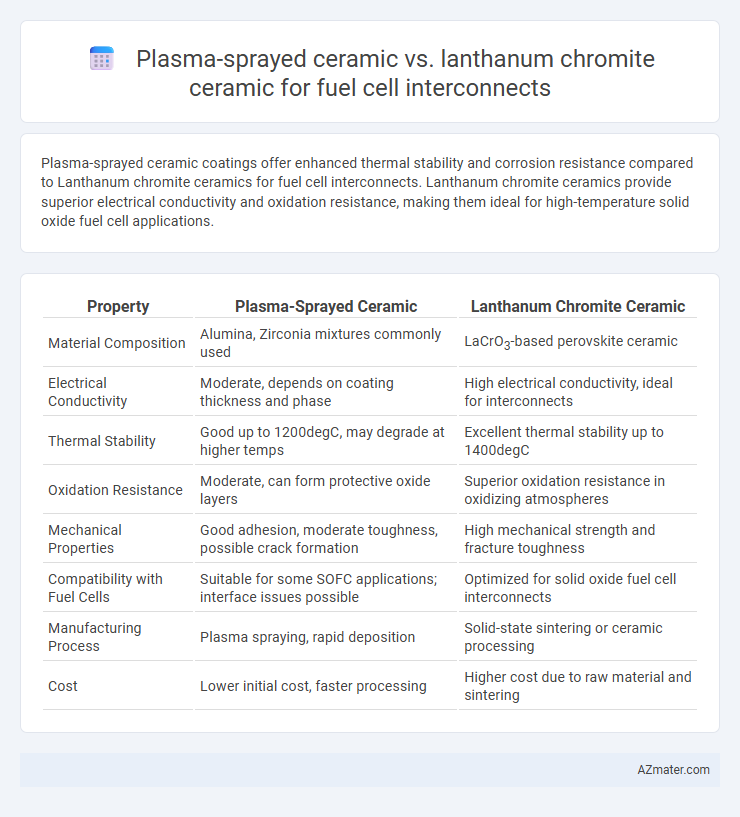Plasma-sprayed ceramic coatings offer enhanced thermal stability and corrosion resistance compared to Lanthanum chromite ceramics for fuel cell interconnects. Lanthanum chromite ceramics provide superior electrical conductivity and oxidation resistance, making them ideal for high-temperature solid oxide fuel cell applications.
Table of Comparison
| Property | Plasma-Sprayed Ceramic | Lanthanum Chromite Ceramic |
|---|---|---|
| Material Composition | Alumina, Zirconia mixtures commonly used | LaCrO3-based perovskite ceramic |
| Electrical Conductivity | Moderate, depends on coating thickness and phase | High electrical conductivity, ideal for interconnects |
| Thermal Stability | Good up to 1200degC, may degrade at higher temps | Excellent thermal stability up to 1400degC |
| Oxidation Resistance | Moderate, can form protective oxide layers | Superior oxidation resistance in oxidizing atmospheres |
| Mechanical Properties | Good adhesion, moderate toughness, possible crack formation | High mechanical strength and fracture toughness |
| Compatibility with Fuel Cells | Suitable for some SOFC applications; interface issues possible | Optimized for solid oxide fuel cell interconnects |
| Manufacturing Process | Plasma spraying, rapid deposition | Solid-state sintering or ceramic processing |
| Cost | Lower initial cost, faster processing | Higher cost due to raw material and sintering |
Overview of Ceramic Materials in Fuel Cell Interconnects
Plasma-sprayed ceramics provide a protective, corrosion-resistant coating with good thermal stability, often used to enhance the durability of metallic interconnects in solid oxide fuel cells (SOFCs). Lanthanum chromite ceramic, specifically doped lanthanum chromite (LaCrO3), exhibits excellent electrical conductivity and chemical stability at high temperatures, making it a preferred bulk material for SOFC interconnects. Comparing these, plasma spraying offers a versatile surface modification method, while lanthanum chromite's intrinsic properties support long-term performance and oxidation resistance in fuel cell environments.
Plasma-Sprayed Ceramic: Composition and Properties
Plasma-sprayed ceramic coatings for fuel cell interconnects typically consist of yttria-stabilized zirconia (YSZ) or alumina, offering high thermal stability and excellent electrical insulation. The plasma-spraying process creates a dense, adherent layer with controlled porosity, enhancing corrosion resistance while maintaining mechanical integrity under thermal cycling. These coatings exhibit superior resistance to oxidation and chromium volatilization compared to lanthanum chromite ceramics, making them suitable for high-temperature solid oxide fuel cells (SOFCs).
Lanthanum Chromite Ceramic: Key Characteristics
Lanthanum chromite ceramic exhibits exceptional high-temperature stability and electrical conductivity, making it ideal for fuel cell interconnects. Its thermal expansion closely matches that of adjoining cell components, reducing mechanical stresses during operation. The material's excellent oxidation resistance and chemical inertness ensure long-term durability in harsh fuel cell environments.
Comparative Structural Integrity and Mechanical Strength
Plasma-sprayed ceramic coatings typically exhibit higher porosity and lower mechanical strength compared to Lanthanum chromite ceramics, which possess superior structural integrity due to their dense, crystalline microstructure. Lanthanum chromite ceramic interconnects demonstrate enhanced resistance to thermal stress and mechanical deformation, critical for maintaining fuel cell longevity and performance under operational conditions. The robust mechanical strength of Lanthanum chromite ceramics reduces the risk of cracking and delamination, making them more reliable for high-temperature solid oxide fuel cell applications.
Electrical Conductivity Performance Analysis
Plasma-sprayed ceramic coatings offer improved electrical conductivity for fuel cell interconnects due to their dense microstructure and strong adherence, reducing contact resistance. Lanthanum chromite ceramics exhibit inherently high electronic conductivity and excellent thermal stability, making them suitable for high-temperature solid oxide fuel cells (SOFCs). Comparative studies reveal that while plasma-sprayed ceramics provide customizable conductivity through process control, lanthanum chromite maintains superior baseline electrical conductivity essential for consistent SOFC performance.
Thermal Stability and Oxidation Resistance
Plasma-sprayed ceramic coatings exhibit excellent thermal stability due to their dense microstructure, which effectively minimizes thermal degradation at high operating temperatures typical of solid oxide fuel cell (SOFC) interconnects. Lanthanum chromite ceramics demonstrate superior oxidation resistance, maintaining structural integrity and electronic conductivity in oxidizing environments up to 1000degC, critical for long-term fuel cell performance. Comparative studies reveal that lanthanum chromite's inherent chemical stability and thermal expansion compatibility with metallic substrates enhance durability, whereas plasma-sprayed ceramics may require optimization to match this oxidation resistance.
Fabrication Methods: Plasma Spraying vs Conventional Sintering
Plasma spraying fabricates ceramic coatings by propelling molten ceramic particles onto a substrate, producing dense, adherent layers with controlled microstructures suitable for fuel cell interconnects. Lanthanum chromite ceramics typically undergo conventional sintering, where powdered materials are compacted and heated at high temperatures to achieve densification and phase stability, resulting in robust but brittle components. Plasma-sprayed ceramics offer enhanced flexibility in layer thickness and microstructural tailoring compared to the uniform density and microstructure achieved through sintering processes.
Cost Implications and Scalability
Plasma-sprayed ceramic coatings offer cost advantages due to lower processing temperatures and faster deposition rates compared to Lanthanum chromite ceramics, which require high-temperature sintering and complex manufacturing steps. Scalability of plasma spraying is enhanced by its adaptability to various substrate geometries and automation potential, enabling mass production at reduced costs. Lanthanum chromite's brittleness and dense microstructure result in higher production costs and challenges in scaling without compromising structural integrity.
Durability and Long-Term Operational Reliability
Plasma-sprayed ceramic coatings offer excellent thermal stability and oxidation resistance, yet they may exhibit microcracking under prolonged thermal cycling, potentially compromising long-term durability in fuel cell interconnects. Lanthanum chromite ceramics demonstrate superior chemical stability and mechanical strength at elevated temperatures, ensuring enhanced long-term operational reliability by resisting degradation and maintaining electrical conductivity over extended periods. The choice between plasma-sprayed and lanthanum chromite ceramics hinges on achieving optimal balance between thermal shock resistance and sustained structural integrity for efficient fuel cell interconnect performance.
Selection Criteria for Optimal Fuel Cell Interconnect Material
Plasma-sprayed ceramic coatings offer superior thermal barrier properties and enhanced oxidation resistance, making them suitable for high-temperature solid oxide fuel cell (SOFC) interconnects. Lanthanum chromite ceramics exhibit excellent electrical conductivity and chemical stability under SOFC operating conditions, crucial for minimizing resistive losses and ensuring long-term durability. Optimal fuel cell interconnect material selection hinges on balancing thermal stability, electrical conductivity, corrosion resistance, and mechanical compatibility with adjoining components.

Infographic: Plasma-sprayed ceramic vs Lanthanum chromite ceramic for Fuel cell interconnect
 azmater.com
azmater.com